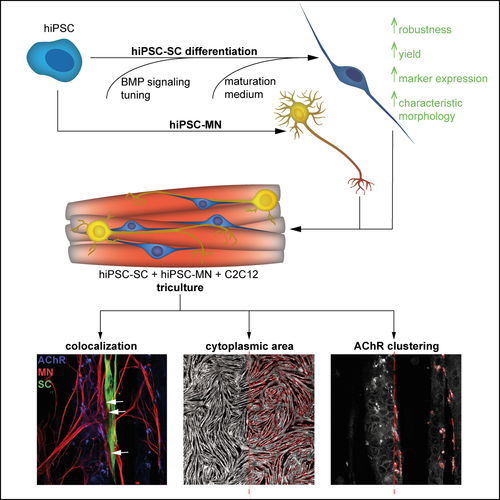Sie befinden sich hier
Inhalt

Professor of Biosensorics, Institute of Molecular and Cell Biology, Mannheim University of Applied Sciences
Member, Center of Mass Spectrometry and Optical Spectroscopy (CeMOS), Mannheim University of Applied Sciences
Investigator, Interdisciplinary Center for Neurosciences (IZN), Heidelberg University
https://www.researchgate.net/profile/Ruediger-Rudolf
https://orcid.org/0000-0002-0833-1053
3D Cell Models for Fundamental and Applied Research
Based on 20 years of research on mouse skeletal muscle, neuromuscular junctions, their innervation by sympathetic neurones, and mechanisms of postsynaptic protein trafficking, we are now focusing on 3D-cell models for fundamental and applied pharmaceutical research, often in cooperation with academic and industrial partners. These cell-based models are mainly for neuronal or cancer research and range from spheroids over chip-based assays up to complex cocultures and organoids. Technological foci are on development of adequate cell culturing techniques, including 3D bioprinting, but also optical tissue clearing protocols, 3D and 4D confocal and light sheet microscopy, and AI-based automated image analysis. In the context of neurosciences, we have been concentrating on the establishment of models for the neuromuscular junction (NMJ).
Central research topics:
- Identifying modes for producing robust three-dimensional neuromuscular in vitro models containing motor neurons, Schwann cells, and muscle fibers.
- Identifying the role of cellular communication for maturation and functional properties of the contributing cell types.

Research projects
MWK: Collaborative research training group "Personalized Medicine and Organoid Pharmaceutical Test Models: Advanced Materials, Analytics, and Computing (Perpharmance)". Project duration: 03/2023 – 02/2026, co-speaker
BMBF: FH-Impuls "M2Aind". Project duration: 01/2023 – 12/2024
- Subproject: Drugs-Data.
BMBF: Synthesis For Synthesis (Syn4Syn): Modelling 3D-Organoids for the Pharmaceutical Drug Screening by Combining Experiment, AI, and Biophysics. Project duration: 01/2022 – 12/2023
DFG: Integrative Analysis of Organoids Enables Mechanistic Studies in Pharmaceutical Research: Development, Volatilomics, Single Cell Metabolite/Lipid Fingerprinting, and Function. Duration: 2022 – 2027
BMBF: FH-Impuls "M2Aind". Project duration: 01/2021 – 12/2022
- Subproject: Drugs4Future.
Carl Zeiss foundation: DigiFIT. Project duration: 02/2019 – 01/2022
BMBF: FH-Impuls "M2Aind". Project duration: 01/2017 – 12/2020
- Subproject: M2OGA.
BMBF: FH-Impuls “Multimodal Analytics and Intelligent Sensorics for the Health Industries”. Duration: 2017 – 2025
BMBF: Forschungscampus Mannheim Molecular Intervention Environment: Molekulare Bioanalytik und Theranostika-Entwicklung. Duration: 2015 – 2025
Legend: DFG = German Research Foundation, BMBF = Federal Ministry of Education and Research, MWK = Ministry of Science, Research and the Arts
Selected publications
- Development and In Vitro Differentiation of Schwann Cells.
Hörner SJ, Couturier N, Gueiber DC, Hafner M, Rudolf R. Cells. 2022. 11(23):3753. - hiPSC-Derived Schwann Cells Influence Myogenic Differentiation in Neuromuscular Cocultures
Hörner SJ, Couturier N, Bruch R, Koch P, Hafner M, Rudolf R. Cells. 2021. 10:3292 - Sweet Taste Is Complex: Signaling Cascades and Circuits Involved in Sweet Sensation.
von Molitor E, Riedel K, Krohn M, Hafner M, Rudolf R, Cesetti T. Front Hum Neurosci. 2021. 15: 667709 - Regulatory Function of Sympathetic Innervation on the Endo/Lysosomal Trafficking of Acetylcholine Receptor.
Straka T, Schröder C, Roos A, Kollipara L, Sickmann A, Williams MPI, Hafner M, Khan MM, Rudolf R. Front Physiol. 2021. 12:626707 - Effects of ASC Application on Endplate Regeneration Upon Glycerol-Induced Muscle Damage.
Rigon M, Hörner SJ, Straka T, Bieback K, Gretz N, Hafner M, Rudolf R. Front. Mol. Neurosci. 2020. 13:107 - Analysis of calcium signaling in live human Tongue cell 3D-Cultures upon tastant perfusion.
von Molitor E, Nürnberg E, Ertongur-Fauth T, Scholz P, Riedel K, Hafner M, Rudolf R, Cesetti T. Cell Calcium 2020, 87, 102164 - Motor Endplate - Anatomical, Functional, and Molecular Concepts in the Historical Perspective.
Rudolf R, Khan MM, Witzemann V. Cells. 2019. 8:387 - A Novel Optical Tissue Clearing Protocol for Mouse Skeletal Muscle to Visualize Endplates in Their Tissue Context.
Williams MPI, Rigon M, Straka T, Hörner SJ, Thiel M, Gretz N, Hafner M, Reischl M, Rudolf R. Front. Cell. Neurosci. 2019. 13:49 - Postnatal Development and Distribution of Sympathetic Innervation in Mouse Skeletal Muscle.
Straka T, Vita V, Prokshi K, Hörner SJ, Khan MM, Pirazzini M, Williams MPI, Hafner M, Zaglia T, Rudolf R. Int. J. Mol. Sci. 2018. 19:1935 - Sympathetic innervation controls homeostasis of neuromuscular junctions in health and disease.
Khan MM, Lustrino D, Silveira WA, Wild F, Straka T, Issop Y, O’Connor E, Cox D, Reischl M, Marquardt T, Labeit D, Labeit S, Benoit E, Molgó J, Lochmüller H, Witzemann V, Kettelhut IC, Navegantes LCC, Pozzan T, Rudolf R. Proc. Natl. Acad. Sci. 2016. 113:746–750
Kontextspalte
Contact
Mannheim University of Applied Sciences
Paul-Wittsack-Str. 10
68163 Mannheim
Phone +49 621 292-6804
r.rudolf@hs-mannheim.de
